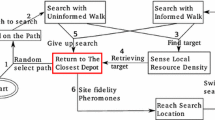Abstract
Foraging is a common benchmark problem in collective robotics in which a robot (the forager) explores a given environment while collecting items for further deposition at specific locations. A typical real-world application of foraging is garbage collection where robots collect garbage for further disposal in pre-defined locations. This work proposes a method to cooperatively perform the task of finding such locations: instead of using local or global localization strategies relying on pre-installed infrastructure, the proposed approach takes advantage of the knowledge gathered by a population about the localization of the targets. In our approach, robots communicate in an intrinsic way the estimation about how near they are from a target; these estimations are used by neighbour robots for estimating their proximity, and for guiding the navigation of the whole population when looking for these specific areas. We performed several tests in a simulator, and we validated our approach on a population of real robots. For the validation tests we used a mobile robot called marXbot. In both cases (i.e., simulation and implementation on real robots), we found that the proposed approach efficiently guides the robots towards the pre-specified targets while allowing the modulation of their speed.
Similar content being viewed by others
References
Arkin RC (1992) Cooperation without communication: multiagent schema-based robot navigation. J Robot Syst 9(3): 351–364
Arkin, RC, Bekey, GA (eds) (1997) Robot colonies. Kluwer, Norwell
Balch T, Arkin RC (1994) Communication in reactive multiagent robotic systems. Auton Robots 1(1): 27–52
Bekey GA (2005) Autonomous robots: from biological inspiration to implementation and control (Intelligent Robotics and Autonomous Agents). The MIT Press, Cambridge
Bencina R, Kaltenbrunner M, Jorda S (2005) Improved topological fiducial tracking in the reactivision system. In: IEEE computer society conference on computer vision and pattern recognition-workshops, 2005. CVPR workshops. IEEE, p 99
Bonani M, Baaboura T, Retornaz P, Vaussard F, Magnenat S, Burnier D, Longchamp V, Mondada F (2009) The marxbot—a modular all-terrain experimentation robot. http://mobots.epfl.ch/marxbot.html
Bonani M, Longchamp V, Magnenat S, Rtornaz P, Burnier D, Roulet G, Vaussard F, Bleuler H, Mondada F (2010) The MarXbot, a miniature mobile robot opening new perspectives for the collective-robotic research. In: 2010 IEEE/RSJ international conference on intelligent robots and systems (IROS 2010). http://mobots.epfl.ch/
Braitenberg V (1984) Vehicles: experiments in synthetic psychology. The MIT Press, Cambridge
Camazine S, Crailsheim K, Hrassnigg N, Robinson GE, Leonhard B, Kropiunigg H (1998) Protein trophallaxis and the regulation of pollen foraging by honey bees (Apis mellifera L.). Apidologie 29(1–2): 113–126
Camazine S, Deneubourg JL, Franks NR, Sneyd J, Theraulaz G, Bonabeau E (2001) Self-organization in biological systems. Princeton University Press, Princeton
Campo A, Gutiérrez A, Nouyan S, Pinciroli C, Longchamp V, Garnier S, Dorigo M (2010) Artificial pheromone for path selection by a foraging swarm of robots. Biol Cybernet 103: 339–352. doi:10.1007/s00422-010-0402-x
Deneubourg JL, Goss S (1989) Collective patterns and decision making. Ethol Ecol Evol 1: 295–311
Floreano D, Mattiussi C (2008) Bio-inspired artificial intelligence: theories, methods, and technologies. The MIT Press, Cambridge
Gadagkar R (1997) Survival strategies: cooperation and conflict in animal societies. Harvard University Press, USA
Ijspeert A, Martinoli A, Billard A, Gambardella LM (2001) Collaboration through the exploitation of local interactions in autonomous collective robotics: the stick pulling experiment. Auton Robots 11(2): 149–171
Kuniyoshi Y, Kita N, Rougeaux S, Sakane S, Ishii M, Kakikua M (1994) Cooperation by observation: the framework and basic task patterns. In: IEEE international conference on robotics and automation, 1994. Proceedings 1994, vol 1, pp 767–774
Kuniyoshi Y, Rickki J, Ishii M, Rougeaux S, Kita N, Sakane S, Kakikura M (1994) Vision-based behaviors for multi-robot cooperation. In: Proceedings of the IEEE/RSJ/GI international conference on intelligent robots and systems ’94, vol 2. ‘Advanced robotic systems and the real world’, IROS ’94, pp 925–932
Lambrinos D, Roggendorf T, Pfeifer R (2001) Insect strategies of visual homing in mobile robots. In: Biorobotics—methods and applications. AAAI Press, pp 37–66
Magnenat S, Waibel M, Beyeler A (2009) Enki—an open source fast 2d robot simulator. http://home.gna.org/enki/
Magnenat S, Rtornaz P, Bonani M, Longchamp V, Mondada F (2010) ASEBA: a modular architecture for event-based control of complex robots. IEEE/ASME transactions on mechatronics PP(99):1–9. doi:10.1109/TMECH.2010.2042722. http://www.ieee-asme-mechatronics.org/
Nouyan S, Gross R, Dorigo M, Bonani M, Mondada F (2005) Group transport along a robot chain in a self-organised robot colony. In: Proceedings of the 9th international conference on intelligent autonomous systems, IOS. IOS Press, pp 433–442
Satizábal HF, Upegui A, Pérez-Uribe A (2010) Social target localization in a population of foragers. In: González JR, Pelta DA, Cruz C, Terrazas G, Krasnogor N (eds) Studies in computational intelligence, vol 284. NICSO. Springer, Berlin, pp 13–24
Schmickl T, Crailsheim K (2006) Trophallaxis among swarm-robots: a biologically inspired strategy for swarm robotics. In: The first IEEE/RAS-EMBS international conference on biomedical robotics and biomechatronics, 2006. BioRob 2006, pp 377–382. doi:10.1109/BIOROB.2006.1639116
Smith JM, Szathmary E (2000) The origins of life: from the birth of life to the origin of language. Oxford University Press, USA
Sugawara K, Kazama T, Watanabe T (2004) Foraging behavior of interacting robots with virtual pheromone. In: Proceedings 2004 IEEE/RSJ international conference on intelligent robots and systems, 2004 (IROS 2004), vol 3, pp 3074–3079. doi:10.1109/IROS.2004.1389878
Werger B, Mataric MJ (1996) Robotic “food” chains: externalization of state and program for minimal-agent foraging. In: Proceedings of 4th internationl conference simulation of adaptive behavior: from animals to animats, vol 4. The MIT Press, pp 625–634
Winfield A (2009) Towards an engineering science of robot foraging. Distrib Auton Robot Syst 8: 185–192
Author information
Authors and Affiliations
Corresponding author
Rights and permissions
About this article
Cite this article
Satizábal, H.F., Upegui, A., Perez-Uribe, A. et al. A social approach for target localization: simulation and implementation in the marXbot robot. Memetic Comp. 3, 245–259 (2011). https://doi.org/10.1007/s12293-011-0061-z
Received:
Accepted:
Published:
Issue Date:
DOI: https://doi.org/10.1007/s12293-011-0061-z




